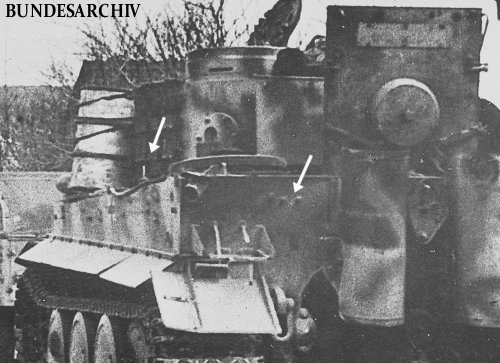About this detail of the Tiger
The Henschel factory that built the Tigers was bombed by Allied aircraft in October 1943. The estimated disruption to Tiger production amounted to a shortfall of 79 units eventually.
The factory had eighteen Befehlstigers in storage waiting to be allocated, three at a time, to new Heavy Tank Battalions or issued as replacements. It was decided to convert these tanks into ordinary Tigers while production was impaired.
The stored Befehlstigers dated back as far as July 1943, i.e. some of them were "Early". Since their manufacture, the factory had built and issued some "Mid" Befehlstigers.
The conversion involved removal of the extra Befehlstiger radios and generator, plus installation of the turret MG and ammunition storage that they had displaced. The smaller details that distinguished a Befehlstiger were not removed, however, and consequently these 18 special Tigers can usually be identified in photos.
The antenna base on the turret roof was removed and the hole patched. The antenna base and ceramic insulator were removed from the armoured pot on the right hull roof, and the hole patched; but the pot remained open. A mantlet with an MG opening was installed (it's not clear whether the tank's own mantlet was drilled or a new one was substituted). The storage tube for the star antenna was removed from the rear wall.
On the outside, these tanks retained the welded mounts for the antenna tube on the rear wall; the generator chimney and its sealing cap on the hull roof; the two holders for the mast antenna on the hull side; and the antenna base on the left of the hull roof. Therefore they had only four S-mine launchers. Their most obvious feature was that they had their antenna on the left side of the hull, on the only remaining antenna base.

This is one of the converted vehicles serving in s.Pz.Abt.506. The left-hand antenna base and the welded mounts for the antenna tube are indicated. Another photo shows the front of this Tiger, including the turret MG opening that marks it as a converted Befehlstiger.
On the inside, these Tigers retained the several small electrical junction boxes that distinguished Befehlstigers, although some of them were no longer usable. The insulated tube leading to the right-hand antenna position remained but the tuning coils were removed from under the armoured pot. The "Mid" Befehlstigers had their turret storage boxes (for headphones etc.) laid out differently to those in a standard "Mid" Tiger; these boxes were left in place. Extra storage for the turret MG accessories and ammunition was squeezed in without removal of the radio junction boxes and sockets from the right-hand wall.
Some of these eighteen ex-Befehlstigers have been identified. They are:
A "Mid" Tiger of an unknown unit, now in Kubinka museum.
The second Tiger 212 of s.Pz.Abt.502, an "Early" Tiger.
Tiger 124 of s.Pz.Abt.505, an "Early" Tiger.
A "Mid" Tiger of 3/s.Pz.Abt.508. This one was issued as a Borgward controller. The unit converted it to a mine layer / recovery vehicle.
A "Mid" Tiger of s.Pz.Abt.508. Seen only in a newsreel, it is distinct from the one previously mentioned.
Tiger 312 of s.Pz.Abt.502, an "Early" Tiger.
Tiger F13 of Gruppe Fehrmann, an "Early" Tiger. This would presumably have been issued to a tank training school at first.
An unidentified "Early" Tiger of s.Pz.Abt.506.